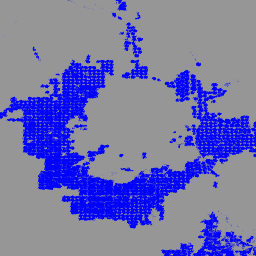
- Доступность набора данных
- 1986-01-01T00:00:00Z–2024-01-01T00:00:00Z
- Поставщик наборов данных
- Университет Монтаны / Климатический офис Монтаны
- Теги
Описание
IrrMapper — это ежегодная классификация состояния орошения в 11 западных штатах США, выполненная в масштабе Landsat (т. е. 30 м) с использованием алгоритма Random Forest, охватывающая период с 1986 года по настоящее время.
В то время как в статье IrrMapper описывается классификация четырех классов (то есть орошаемые, засушливые, необрабатываемые, водно-болотные угодья), набор данных преобразуется в бинарную классификацию орошаемых и неорошаемых земель.
«Орошаемые» означает обнаружение любого орошения в течение года. Модель случайного леса IrrMapper обучалась с использованием обширной геопространственной базы данных о земельном покрове каждого из четырёх классов орошаемых и неорошаемых земель, включая более 50 000 орошаемых полей, подтверждённых человеком, 38 000 полей на засушливых землях и более 500 000 квадратных километров необрабатываемых земель.
В версии 1.2 исходные обучающие данные были значительно расширены, построена модель радиочастот для каждого штата, а также проведены более тщательная валидация и анализ неопределенности. См. дополнение к нашей статье о влиянии орошения на речной сток.
Группы
Размер пикселя
30 метров
Группы
| Имя | Размер пикселя | Описание |
|---|---|---|
classification | метров | Орошаемые пиксели имеют значение 1, остальные пиксели маскируются. |
Условия эксплуатации
Условия эксплуатации
Цитаты
Кетчум, Д.; Дженчо, К.; Манета, М.П.; Мелтон, Ф.; Джонс, М.О.; Хантингтон, Дж. IrrMapper: подход машинного обучения для картографирования с высоким разрешением орошаемого земледелия на западе США, Remote Sens. 2020, 12, 2328. doi:10.3390/rs12142328
Кетчум, Д., Хойлман, З.Х., Хантингтон, Дж. и др. Интенсификация орошения влияет на устойчивость речного стока на западе США. Commun Earth Environ 4, 479 (2023). doi:10.1038/s43247-023-01152-2
Исследуйте с Earth Engine
Редактор кода (JavaScript)
var dataset = ee.ImageCollection('UMT/Climate/IrrMapper_RF/v1_2'); var irr = dataset.filterDate('2023-01-01', '2023-12-31').mosaic(); var visualization = { min: 0.0, max: 1.0, palette: ['blue'] }; Map.addLayer(irr, visualization, 'IrrMapper 2023'); Map.setCenter(-112.516, 45.262, 10);
